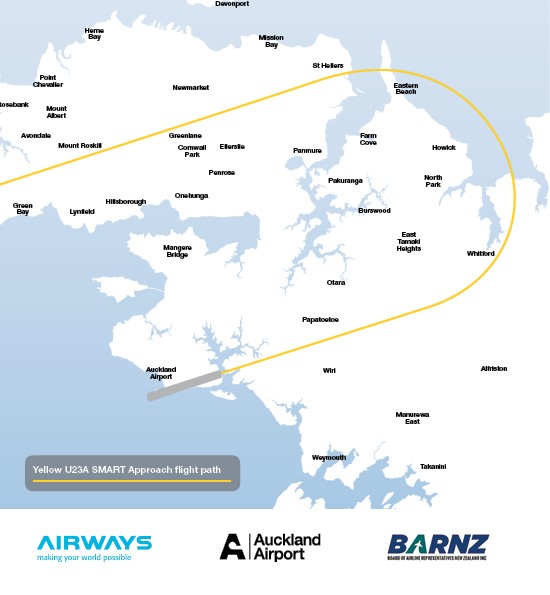23 May 2018
Airways New Zealand, Auckland Airport and the Board of Airline Representatives New Zealand (BARNZ) published today the final report on the trial of the Yellow U23 SMART Approach flight path.
The decision to trial this third satellite-guided flight path to Auckland Airport from the north was publicly announced by the aviation industry in December 2014. The 12-month trial of the flight path, known as the ‘Yellow U23 SMART Approach’, commenced on 1 September 2015 and concluded on 31 August 2016. A draft report on the trial was published on 20 October 2017 and was followed by a public consultation process. Written submissions on the draft report were accepted until 5pm on 15 November 2017, and there was an opportunity for members of the community to present their submissions in person at a meeting held in Nixon Park, Howick on 17 November 2017.
The trial flight path was used between 7am and 10pm by up to 10 aircraft per day. It was flown by 441 aircraft, saving 3,396 nautical miles and 78,710 kilogrammes of fuel, and reducing carbon dioxide emissions by 248,724 kilogrammes. Data was gathered from eight noise monitors in the community during the trial, four of which were located under or near the Yellow U23 SMART Approach flight path. Noise experts concluded that the difference in noise exposure on a day with 10 Yellow U23 SMART Approach flights and a day with no Yellow U23 SMART Approach flights was less than one decibel, or imperceptible, at most monitor sites. There were two exceptions to this – in Whitford where the difference was a “just perceptible” four decibel difference and in Remuera where the difference was an “imperceptible” two decibel difference.
Airways New Zealand’s general manager air traffic services, Tim Boyle, says, “SMART Approaches are an example of best practice international air traffic management. They are becoming more and more common place in New Zealand – operating in Auckland, Christchurch, Queenstown and shortly in Wellington. They are popular because they typically use less fuel, reduce aircraft noise and deliver significant benefits for the environment.”
BARNZ’s executive director, Justin Tighe-Umbers, says, “Notwithstanding the low level of aircraft noise measured in the communities during the trial, Airways, BARNZ and Auckland Airport have modified the flight path to further avoid populated areas. It is now almost 1.5 kilometres off the coast of Eastern Beach, Mellons Bay, Cockle Bay and Waikiteroa Reserve, on average, and it’s also now around half a kilometre south-east of Whitford. Aircraft using the modified flight path will also be higher at 5,000 feet when they fly over Bucklands Beach and 2,800 feet when flying south-east of Whitford. While these modifications would result in a slightly longer flight path for aircraft than trialled, they will reduce the impact of the flight path on the local communities.”
Auckland Airport’s general manager of operations, Anna Cassels-Brown, says, “The modified flight path will become operational in March 2019. Aircraft will only be able to use it between 7am and 10pm, with a maximum of six flights per day. That maximum number of flights per day can be increased to 10 in the future if certain conditions, outlined in the final report, are met. A third satellite-guided flight path to Auckland Airport from the south will also be trialled from March 2019.”
More information about SMART Approaches and a copy of the final report on the Yellow U23 SMART Approach flight path trial is available online at http://www.aucklandflightpathtrial.co.nz/.
Attachments:
Map of Yellow U23A SMART Approach flight path (see below)
2015-2016 Yellow U23 SMART Approach Flight Path – Final Report 2018
For further information please contact:
Emily Davies, Airways New Zealand, 021 815 149
Justin Tighe-Umbers, BARNZ, (09) 358 0696
Auckland Airport Public Affairs, 027 406 3024
